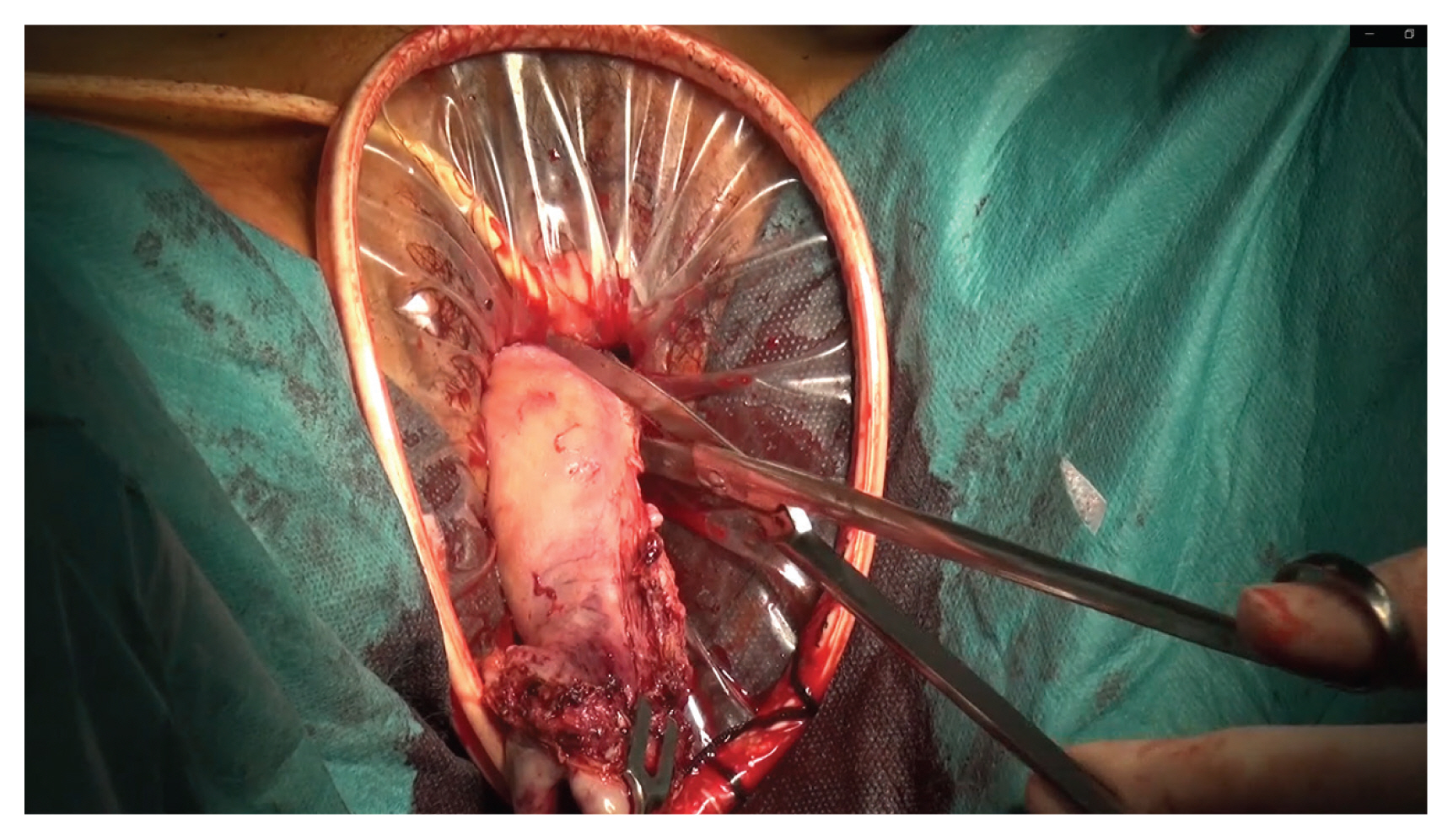Technique for transvaginal removal of large specimen using an Alexis Contained Extraction System during laparoscopic hysterectomy
Article information
Abstract
Objective
Transvaginal removal of large specimens during laparoscopic hysterectomy can be a complex surgical procedure that poses a risk of organ injury and tissue spillage into the abdominal cavity and is associated with extraction of the specimen and manual morcellation. Our objective was to demonstrate a technique for transvaginal removal of large specimens using the Alexis Contained Extraction System (CES) in laparoscopic hysterectomy.
Methods
The technique used for transvaginal removal of large specimens using the Alexis CES was presented in this video. Surgery was performed at a tertiary hospital.
Results
Following resection of the specimen during laparoscopic hysterectomy, the Alexis CES was inserted into the abdominal cavity through the umbilical trocar wound. The specimen was placed in a bag to prevent tissue spillage. The ring retractor was guided to the vagina and pulled out transvaginally. By repeatedly turning the ring retractor, tension was applied to the specimen bag, and the vaginal wall was unfolded all around to enable a secure surgical field. During manual morcellation of the specimen in the bag, the retractor was pulled and additionally turned to roll and re-tension the specimen bag when the bag was loosened. The specimen was pushed out of the vagina and safely and effectively extracted without concerns about tissue spillage in the abdominal cavity or related organ injuries.
Conclusion
The technique for transvaginal removal of large specimens using the Alexis CES enables simple, effective, and safe tissue extraction with contained manual morcellation during laparoscopic hysterectomy.
With advances in surgical techniques and devices, the use of minimally invasive surgery at present encompasses extraction of even large specimens; however, extraction of specimens from giant myoma and adenomyosis poses a major challenge [1,2]. In minimally invasive gynecologic surgery, extraction of large specimens is commonly performed with or without manual or electromechanical morcellation, either through the trocar wound with an extended incision, an additional abdominal wound, or the vaginal canal [3]. Inefficient tissue containment and extraction can potentially affect patient safety and postoperative outcomes [4]. Therefore, tissue containment and extraction are becoming increasingly important elements in surgical procedures [5]. In laparoscopic or robotic hysterectomy for benign gynecological diseases, the resected vaginal canal is often used as a pathway to remove the specimen transvaginally, often necessitating tissue morcellation for extraction of large specimens. However, in patients with obesity, nullipara, and narrow or atrophic vagina, transvaginal removal of large specimens in cases of benign disease can be a complex surgical procedure that poses a risk of organ injuries involving the vaginal and perineal wall, bladder, and intestinal tracts due to lack of an adequate surgical field. Furthermore, consideration must be given to tissue spillage into the abdominal cavity associated with extraction of the specimen and manual morcellation [4–6]. Thus, safe and efficient extraction procedures and surgical devices are required to avoid these complications and concerns in such situations.
The Alexis Contained Extraction System (CES) (Applied Medical, Rancho Santa Margarita, CA, USA) is a device that consists of a rigid ring retractor of 14 cm or 17 cm in diameter and a contained bag with a capacity of 3,400 mL or 6,500 mL, which is mainly used for extraction of specimens in minimally invasive gastrointestinal surgery. The Alexis CES facilitates easy and safe extraction of specimens from the abdominal cavity through the abdominal wall by providing atraumatic abdominal wall retraction. Further, it stores the specimens in a bag to prevent tissue spillage and contamination of the abdominal cavity by gastrointestinal bacteria associated with extraction of the specimen [7,8]. Although transabdominal use of the Alexis CES in minimally invasive gastrointestinal surgery has been discussed in previous reports [7,8], to the best of our knowledge, its use in transvaginal extraction of specimens related to the field of minimally invasive gynecologic surgery has not been reported.
Herein, we demonstrate a technique that enables safe and effective transvaginal removal of large specimens using the Alexis CES in laparoscopic hysterectomy. After resection of the specimen during laparoscopic hysterectomy, the Alexis CES was inserted into the abdominal cavity through the umbilical trocar wound. The specimen was placed in a bag to prevent tissue spillage. The ring retractor was then guided to the vagina and pulled out through the vaginal canal. By repeatedly turning the ring retractor, tension was applied to the specimen bag, and the vaginal wall was unfolded all around, thereby providing a secured surgical field (Fig. 1). During manual morcellation of the specimen outside the bag, the retractor was pulled and turned to roll and re-tense the specimen bag when the tension of the bag was loosened as the process of morcellation advanced. By applying continuous tension to the bag, the specimen is pushed out of the vagina and safely and effectively extracted without concerns about tissue spillage in the abdominal cavity and the related complications of organ injuries involving the vaginal wall, bladder, and intestinal tracts.

Transvaginal removal of the specimen using the Alexis Contained Extraction System (CES) during laparoscopic hysterectomy. The Alexis CES enables effective and safe tissue specimen extraction by maintaining a secure surgical field and applying tension to the specimen bag.
In conclusion, tissue containment and extraction of large specimens is a major challenging procedure in minimally invasive surgery, but this technique for transvaginal removal of large specimens using the Alexis CES enables simple, effective, and safe tissue extraction with contained manual morcellation in laparoscopic hysterectomy.
Notes
Conflict of interest
We declare no potential conflict of interest relevant to this article.
Ethical approval
This study was approved by the Institutional Review Board (IRB) of the Federation of National Public Service Personnel Mutual Aid Associations, Tachikawa Hospital (IRB No. 2021-04). The study was performed in accordance with the principles of the Declaration of Helsinki.
Patient consent
The patient provided written informed consent for publication of this manuscript and related videos.
Funding information
None.
Video clip
Video can be found with this article online at https://doi.org/10.5468/ogs.21358.
ogs-21358-v1.mp4